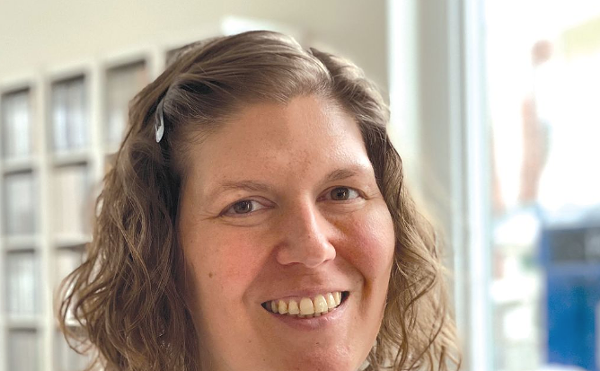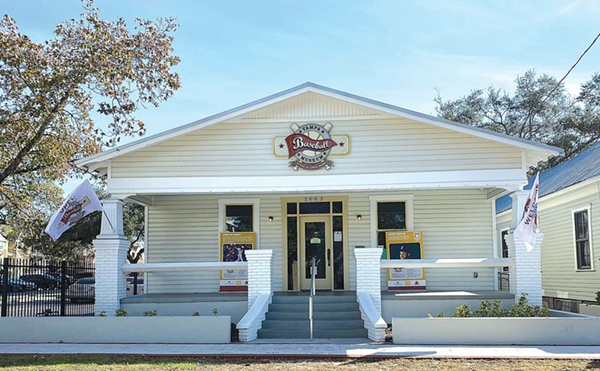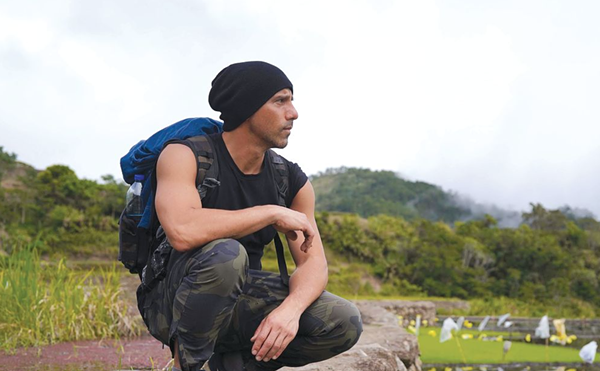
By its nature, a mid-career survey takes viewers on a journey with an artist, granting passage through a landscape of work. That's doubly true in the case of New York-based artist Janet Biggs, a video artist whose projects have explored conditions beyond the boundaries of ordinary human experience in locations as diverse as Utah's Bonneville Salt Flats, a Harlem church, and the disappearing ecosystem of the Arctic Circle. The mid-career survey of her work on view through Jan. 8 at the Tampa Museum of Art, No Limits: Janet Biggs, marks a journey several times over.
Across their disparate settings, Biggs's videos serve as vehicles for an overarching theme. The people who are the subjects of her videos (some of whom might better be described as her collaborators) share a commitment to performances — whether in labor, art or sport — that require staggering endurance and effort (and sometimes yield astonishing achievements). With her camera, Biggs witnesses such acts and re-contexualizes them into works of art that explore a universal human drive — sometimes inspiring, sometimes absurd, but always engrossing — to find and define who we are by exploring what we're capable of.
As a mid-career survey, No Limits is deeply satisfying in that it offers a view of the artist finding and testing her own limits as well, over the course of more than a decade. Roughly two-thirds of the exhibition provides a long introduction for Biggs's most recent work, in which the psychic extremes that fascinate her emerge in fullest form and her own performance as an artist becomes increasingly daring and moving.
Earlier videos, from 1999 to the mid-2000s, feel more conceptually driven. In the installation Flight (1999), Biggs juxtaposes videos of synchronized swimmers and a sleeping horse with a photograph of astronaut John Glenn, inviting viewers to make complicated connections about gender as performance. By comparison, the single-screen video Duet (2010) makes its point much more clearly and elegantly: footage of hyper-masculine NASCAR pit teams in action intermingles with an ethereal duet between an opera singer and a violinist (both women), rendering the former's leaps and squats around race cars into an improbable ballet.
Within the exhibition, the 2009 video Vanishing Point marks a transition in Biggs's work where her fascination with unusual performances fuses with her attraction to out-of-the-ordinary locations. The video documents motorcycle racer Leslie Porterfield's 2008 world-record-setting ride across the Bonneville Salt Flats at 234 mph. Intercut with footage of a Harlem-based choir singing, the video shows Porterfield balanced with cat-like agility atop her motorbike in a black-and-white leather suit. In turns, the racer flies silently across the blindingly white landscape while the choir — the Addicts Rehabilitation Center Gospel Choir, whose members are all former drug and alcohol addicts — sings soulfully of transcendence, their song's lyrics written by Biggs.
"I liked the idea of having the voice be not the world-record setter's but conveying a sense of who she was," Biggs explains.
Two trips to the Arctic Circle in 2009 and 2010, where Biggs traveled as part of an interdisciplinary residency for artists and scientists, have yielded some of her most compelling works to date. Fade to White (2010), the product of her first voyage, follows a Norwegian explorer as he kayaks through an alternately awe- and fear-inspiring landscape of glaciers and ice-strewn waters. (While paddling alongside him in her own kayak, Biggs was warned that a nearby glacier could calve — or let loose an icy landslide — at any moment and kill them both.) Between shots of the young Norwegian man against the frigid landscape, viewers watch slender counter-tenor John Kelly, clad in white against a white backdrop, perform a melancholy aria that matches the landscape's oscillation between sublime and endangered.
A second Arctic project, Brightness All Around (2011), finds Biggs following Arctic miner Linda Norberg, a woman whose job is to descend into newly opened mines and reinforce the ceilings for the safety of the other miners in her company, all of whom are men. (Norberg's performance pendant is the black leather-clad, sensuously dancing Bill Coleman, who belts out lyrics based on accounts of near-death experiences between shots of the miner at work.) Passage into some of the deepest mines was so dangerous that Biggs taught Norberg and others to operate her cameras when the mining company forbade her to go further, despite her willingness to do so.
"I can put myself in the moment enough that I don't question risk," Biggs says. "When I get back to the States, I think. 'Oh my god, what was I thinking?'".
That question came close to interfering with Biggs's latest project, a shoot inside an active volcano in Indonesia where workers mine for sulfur amid toxic gases that often ruin their lungs, throats, eyes and teeth. (She's currently working to edit the footage into a finished piece.) She traveled there earlier this year with her husband, who took time off from work to serve as her assistant. Choking on sulfuric gases and negotiating the mine's treacherous paths with her spouse, the artist realized she'd gotten more than she'd bargained for. The same proved true of her encounter with the miners, whose horrific labor made her question her role as witness and the role of politics in her work, an issue that first arose when the Arctic became a context for her videos.
"Just by the very nature of where I focus my camera, it is political. But I'm not at my best when I try to pursue that path. I'm at my best when I try to find some kind of poetry or other meaning there," Biggs says.
















